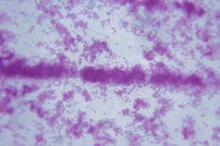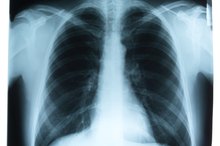What Are the Causes of Communicable Diseases?
Communicable diseases are those that are spread from one person to another person, from animal to animal, or from animal to person, or vice versa. It is likely that everyone will come down with a communicable disease at some point in their lives. It is important to learn about the causes of communicable diseases and ways to prevent their spread. For example, some may say that HIV is caused by sexual contact. This is not true. It is simply the way it is spread. Causes of communicable diseases are dependent on a number of factors, including the agent, environment, transfer method and host.
If you are experiencing serious medical symptoms, seek emergency treatment immediately.
The Agent
In most cases, communicable diseases are either viruses or bacteria. These are known as agents. Both have the ability to cause remarkably similar symptoms. In most cases, those who are unsure should be checked by a doctor in order to get an accurate diagnosis. In both cases, the doctor can prescribe a treatment plan, if one exists, for the patient.
- In most cases, communicable diseases are either viruses or bacteria.
- In most cases, those who are unsure should be checked by a doctor in order to get an accurate diagnosis.
Environment
What Causes Hardening of the Lungs?
Learn More
One of the primary causes of communicable diseases is the environment. Diseases are much more likely to spread in places where hygienic practices are minimal. Furthermore, being around those with communicable diseases is also a high-risk factor. Therefore, care should be taken to keep the environment as clean as possible and avoid direct contact with those who are ill whenever possible.
- One of the primary causes of communicable diseases is the environment.
- Furthermore, being around those with communicable diseases is also a high-risk factor.
Transfer Method
Communicable diseases can be transferred in a number of different ways. The most dangerous are those that can be transferred through the air. Bodily fluids also present a prime vehicle for transfer, especially saliva, mucus and blood. Sexual contact is another way to transmit some forms of communicable diseases.
- Communicable diseases can be transferred in a number of different ways.
- Bodily fluids also present a prime vehicle for transfer, especially saliva, mucus and blood.
Host
What Is the Chain of Infection for Tuberculosis?
Learn More
Every virus must have a host in order to carry out a life cycle of replication, which is responsible for eventually making a person becoming ill. Bacteria, which can live for an extended period of time outside of a host, still need to find one eventually. Therefore, these agents are engineered by evolution to seek out a host as quickly as possible.
Prevention
In order for a communicable disease to flourish, all of these factors must be in place. In some cases, the agent can be prevented through a vaccine. In other cases, fighting communicable disease centers on the environment, transfer method or host. Keeping surroundings clean, avoiding transfer methods and practicing healthy eating and exercise habits can all help. Wearing a mask can also be helpful.
- In order for a communicable disease to flourish, all of these factors must be in place.
- In some cases, the agent can be prevented through a vaccine.
Treatment
Once a disease does infect a person, there may be a number of different choices. Antiviral medications can help weaken the virus. Antibiotics can kill a bacteria. However, there some viruses that are immune to antiviral products and some bacteria have become resistant to antibiotics. In some cases, treatment relies on controlling, rather than defeating, the infection.
- Once a disease does infect a person, there may be a number of different choices.
Related Articles
Writer Bio
Kenneth Black has been a freelance writer since 2008. He currently works as a staff writer for "The Times Republican" in Central Iowa. He has written extensively on a variety of topics, including business, politics, family life and travel. Black holds a bachelor's degree in business marketing from the University of Phoenix.









